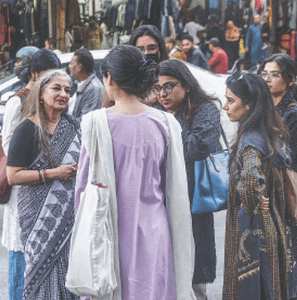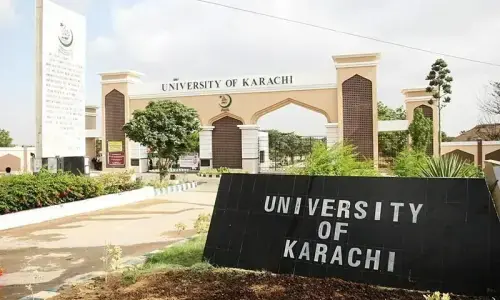One day, while having lunch at a restaurant off I.I. Chundrigar Road (formerly McLeod Road) I looked out the window. The colonial buildings on either side of the thoroughfare have two things in common: they are well-embellished and are big in size. This spaciousness must mean something, I thought to myself. Surely, the phrase ‘size matters’ would not have been in common use a hundred years back. Does it represent the grandeur and pomposity associated with colonial rulers? Does it have architectural reasons? Is it the weather conditions of the coastal town which caused the designers not to come up with blueprints for smaller buildings? It could be anything.
Then my mind turned to McLeod, after whom this road was named before Pakistan became a reality. Who was he? He cannot be the person whom the one and only Mirza Asadullah Khan Ghalib had paid tribute to in the following words:
Jam rutba McLeod bahadur ka waqt-i-razm Turk-i-falak ke hath se wo chheen le husaam (So brave is Mr McLeod that on the battlefield He can snatch the sword even from the cruel fate’s hands)
Perhaps the greatest Urdu poet was referring to Donald Friell McLeod (1810-1872). He was a lieutenant governor in Punjab and known for his philanthropic deeds. He is said to be among those who founded Punjab University. However, it is not likely that Karachi’s McLeod Road was named after him.
Another conjecture is that it was James John McLeod, a British army officer who was born in India in 1830. John McLeod was of Scottish descent and is known in history (British history or Indian history, depending which side of the fence you stand) to have played an important role in quelling the 1857 mutiny. He is believed to be the person who got hold of the first gun given up or left behind by the mutineers. As a result, he was bestowed with Victoria Cross. He died in England in 1907. It is quite likely that Karachi’s McLeod Road, as a few other roads and places in other parts of India, was dedicated to him. Let’s leave that to researchers, for journalists have to contend with exigencies related to deadlines.
Befitting the royal background of the person(s) mentioned above, the colonial buildings on McLeod Road are grand in style and large in size. There are many structures flanking the road which remind you of a glorious past, and some of them, by the way, were not erected when Mr McLeod was alive – they’re a later construction, let’s say, round about the time when India had begun itching for independence. Most of them, however, remind you of the period when elaborate decorative elements on buildings were in vogue, although only facades of a big number of such structures now remain.Heading towards Habib Bank Plaza from the Shaheen Complex roundabout, a little away from the famous bank from colonial times which has a semicircular front, there is a big building where insurance related work is undertaken. The first thing that immediately comes to mind is its solid-as-rock construction. It does not look like a 19th century piece and appears to be a subsequent construction, pre-partition nonetheless. Its rectilinear and square windows beckon history buffs to visit it. Not a good idea if it’s a working day. Perhaps a bit of a touchup will not do harm to the sturdy building.
Across the road is a compound whose façade is, in modern parlance, mind-blowing. Part of it is intact and part of is only the façade with only its rear portion existing. It’s Badri Building. The intact part seems to have been recently restored and refurbished. It’s looking absolutely gorgeous. The decorative elements take you back in time when buildings were treated like attires. The portion which has been hollowed out requires a fair bit of attention though.
Now hop back on the other side and move ahead a little. You will see a huge compound-like structure with an arched entrance.
It’s Nadir House. The building is not in an alarming state. It is in decent condition and those who use it (and they are quite a few people who do that) have kept it well. You can easily understand from its sheer size that it houses different offices. According to the chowkidar of the building, it was built way before partition. One of chowkidar’s friends believes that once it functioned as a hospital as well (hard to verify that). The fact is: Nadir House is a good looking piece of construction with simple architectural characteristics.
Architect Arif Hasan says: “Historically this area had big buildings, especially after the cotton boom (which came after the American civil war crisis) different companies established their warehouses and offices here. McLeod Road was developed along the railway track: offices were in front and warehouses at the back. Probably the older buildings were demolished to make way for palatial structures.”
Mr McLeod (either of the two) has become part of the subcontinent’s history. The good thing is that some of the buildings constructed in the locality named after him are living in the ‘now’. They should be preserved to facilitate their transition into the future with dignity and grace.
mohammad.salman@dawn.com


































